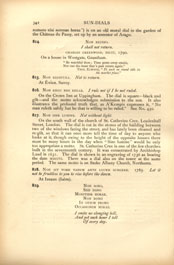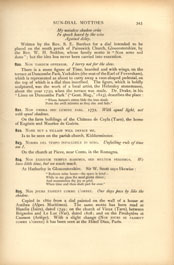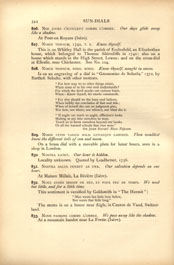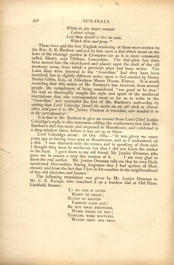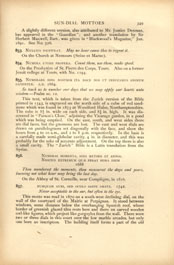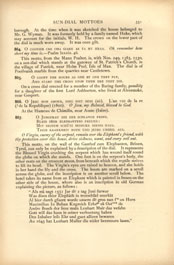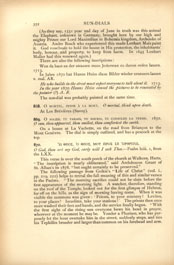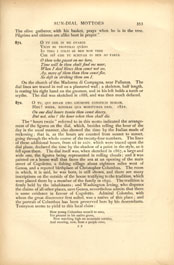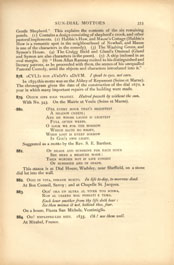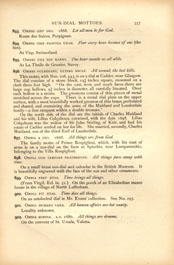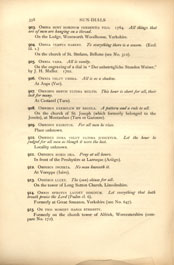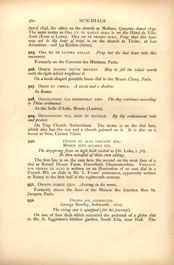Sun-Dial Mottoes (continued.)
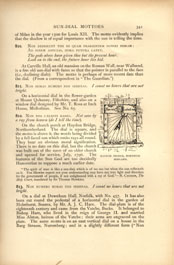
[Full Image]
HAYDON BRIDGE, NORTHUMBERLAND.
of Milan in the year 1500 for Louis XII. The motto evidently implies that the shadow is of equal importance with the sun in telling the time. |
|
| 810. | NON DEDERUNT TIBI DI QUAM PRAESENTEM SUPERI HORAM: At Carville Hall, an old mansion on the Roman Wall, near Wallsend, is a fine old sun-dial with faces so that the pointer is parallel to the face (i.e., declining dials). The motto is perhaps of more recent date than the dial. (From a correspondent in "The Guardian.") |
| 811. | NON HORAS NUMERO NISI SERENAS. I count no hours that are not bright. On a horizontal dial in the flower-garden at Mount Quhanny, Fifeshire, and also on a window dial designed by Mr. T. Ross at Inch House, Midlothian. See No. 65. |
| 812. | NON NISI CÆLESTI RADIO. Not save by a ray from heaven (do I tell the time). On a church porch at Haydon Bridge, Northumberland. The dial is square, and the motto is above it, the words being divided by a full-faced sun which emits rays all round. They bear an obvious moral signification. There is no date on this dial, but the church was built out of the nave of an older church and opened for service, July, 1796. The features of the Sun God are too decidedly Hanoverian to suppose a much earlier date. "The spirit of man is like a sun-dial, which is of no use but when the sun reflecteth on it. You likewise expect not your understanding may have any true light and direction for the government of people, if not enlightened with a ray of God." – N. CAUSSIN, The Holy Court, translated by Sir Thomas Hawkins. |
| 813. | NON NUMERO HORAS NISI SERENAS. I count no hours that are not bright. On a dial at Downham Hall, Norfolk, with No. 457. It has also been cut round the pedestal of a horizontal dial in the garden of Holmhurst, Sussex, by Mr. A. J. C. Hare. The dial-plate is of the eighteenth century and came from the Vatche, Bucks. It belonged to Bishop Hare, who lived in the reign of George II. and married Miss Alston, heiress of the Vatche; their arms are engraved on the plate. The same motto is on an east vertical dial on a house in the Burg Strasse, Nuremberg; and in a slightly different form ("Non |
| numero nisi serenas horas") is on an old mural dial in the garden of the Château de Passy, set up by an ancestor of Arago. | |
| 814. |
NON REDIBO. On a house in Westgate, Grantham.
"Be watchful thou; Time posts away amain, |
| 815. | NON REDITURA. Not to return. At Évian, Savoy. |
| 816. | NON REGO NISI REGAR. I rule not if I be not ruled. On the Crown Inn at Uppingham. The dial is square – black and gilt – and the motto acknowledges submission to the sun. It also illustrates the profound truth that, as A'Kempis expresses it, "No man ruleth safely but he that is willing to be ruled."See No. 450. |
| 817. | NON SINE LUMINE. Not without light. On the south wall of the church of St. Catherine Cree, Leadenhall Street, London. The dial is cut in the stones of the building between two of the windows facing the street, and has lately been cleaned and re-gilt, so that it can once more tell the time of day to anyone who looks at it, though owing to the height of the opposite houses there must be many hours in the day when "Sine lumine" would be only too appropriate a motto. St. Catherine Cree is one of the few churches built in the seventeenth century. It was consecrated by Archbishop Laud in 1631. The dial is shown in an engraving of 1736 as bearing the date MDCCVI. There was a dial also on the tower at the same period. The same motto is on Stoke Albany Church, Northants. |
| 818. | NON SIT VOBIS VANUM ANTE LUCEM SURGERE. 1765. Let it not be fruitless to you to rise before the dawn. At Izeaux (Isère). |
| 819. |
NON SONO, |
My noiseless shadow cries Written by the Rev. S. E. Bartleet for a dial intended to be placed on the south porch of Painswick Church, Gloucestershire, by the Rev. W. H. Seddon, whose family motto is "Non sono sed dono"; but the idea has never been carried into execution. |
|
| 820. | NON TARDUM OPPERIOR. I tarry not for the slow. There is a stone figure of Time, bearded and with wings, on the terrace at Duncombe Park, Yorkshire (the seat of the Earl of Feversham), which is represented as about to carry away a vase-shaped pedestal, on the top of which is a dial thus inscribed. The figure, which is boldly sculptured, was the work of a local artist, the Helmsley stonemason, about the year 1750, when the terrace was made. Dr. Drake, in his "Lines on Duncombe Park" ("Gent. Mag.," 1823), describes the place: "Where Saturn's statue bids the iron shade, |
| 821. | NON UMBRA SED LUMINE PARI. 1772. With equal light, not with equal shadows. On the farm buildings of the Château de Cayla (Tarn), the home of Eugénie and Maurice de Guérin. |
| 822. | NONE BUT A VILLAIN WILL DEFACE ME. Is to be seen on the parish church, Kidderminster. |
| 823. | NORMA DEL TEMPO INFALLIBILE IO SONO. Unfailing rule of time am I. On the church at Pieve, near Cento, in the Romagna. |
| 824. | NOS EXIGUUM TEMPUS HABEMUS, SED MULTUM PERDIMUS. We have little time, but we waste much. At Hatherley in Gloucestershire. Sir W. Scott says likewise: "Redeem mine hours – the space is brief – |
| 825. | NOS JOURS PASSENT COMME L'OMBRE. Our days pass by like the shadow. Copied in 1860 from a dial painted on the wall of a house at Antibes (Alpes Maritimes). The same motto has been read at Blandin (Isère), dated 1749; on the church of Vieux (Tarn), between Brignoles and Le Luc (Var), dated 1808; and on the Presbytère at Causson (Ariège). With a slight change (NOS JOURS SE PASSENT COMME L'OMBRE) it has been seen at the Hôtel Dieu, Paris. |
| 826. | NOS JOURS S'ÉCOULENT COMME L'OMBRE. Our days glide away like a shadow. At Pont-en-Royans (Isère). |
| 827. | NOSCE TEIPSUM, 1740, T. S. Know thyself. This is on Whitley Hall in the parish of Ecclesfield, an Elizabethan house, which belonged to Thomas Shirecliffe in 1740; also on a house which stands in the High Street, Lewes; and on the cross-dial at Elleslie, near Chichester. See No. 104. |
| 828. | NOSCE TEIPSUM, NIHIL NIMIS. Know theyself, naught in excess. Is on an engraving of a dial in "Gnomonice de Solariis," 1572, by Barthol: Schultz, with other mottoes.
|
| 829. | NOSSE CUPIS VARIOS SOLIS LUNAEQUE LABORES. Thou wouldest know the different toils of sun and moon. On a brass dial with a movable plate for lunar hours, seen in a shop in London. |
| 830. | NOSTRA LATET. Our hour is hidden. Locality unknown. Quoted by Leadbetter, 1756. |
| 831. | NOSTRA SALUS PENDET AB UNA. Our salvation depends on one hour. At Maison Millaiz, La Rivière (Isère). |
| 832. | NOUS AVONS BESOIN DE PEU, ET POUR PEU DE TEMPS. We need but little, and for a little time. This sentiment is versified by Goldsmith in "The Hermit": "Man wants but little here below, The motto is on a house near Aigle, in Canton de Vaud, Switzerland. |
| 833. | NOUS PASSONS COMME L'OMBRE. We pass away like the shadow. At a mountain hamlet near La Frette (Isère). |
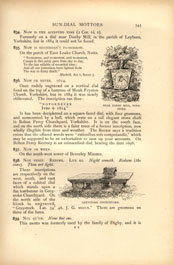
[Full Image]
NEAR DANBY MILL, YORKSHIRE.
GREYSTOKE CHURCHYARD.
| 834. | NOW IS THE ACCEPTED TIME (2 Cor. vi. 2). Formerly on a dial near Danby Mill, in the parish of Leyburn, Yorkshire, but in 1884 it could not be found. |
| 835. | NOW IS YESTERDAY'S TO-MORROW. On the porch of East Leake Church, Notts. "To-morrow, and to-morrow, and to-morrow, |
| 836. | NOW OR NEVER. 1614. Once rudely engraved on a vertical dial fixed on the top of a buttress of Monk Fryston Church, Yorkshire, but in 1884 it was nearly obliterated. The inscription ran thus: "N O V O R N E V E R It has been deciphered on a square-faced dial, with four gnomons, and surmounted by a ball, which rests on a tall elegant stone shaft in Bolton Percy Churchyard, Yorkshire. It is on the south face, and on the north side there is a faint trace of a former inscription, now wholly illegible from time and weather. The Rector says a tradition exists that the effaced words were "rationibus suis computandis," which may be supposed to be an exhortation to sum up your accounts. On Bolton Percy Rectory is an uninscribed dial, bearing the date 1698. |
| 837. | NOW OR WHEN. On the south-west tower of Beverley Minster. |
| 838. | NOX VENIT. REDIME. LUX ES. Night cometh. Redeem (the time). Thou art light. These inscriptions are respectively on the west, south, and east faces of a cubical dial which stands upon a flat tombstone in Greystoke Churchyard. On the north side of the block is engraved, "Graystock. Lat. 54" 46. J. G. MDCCX. " There are gnomons on three of the faces. |
| 839. | NUL QU'UN. None but one. This motto was formerly used by the family of Digby, and it is |
| engraved with their arms and the date 1670 on a dial at Gayhurst House, near Olney. The Digbys owned Gayhurst from 1596 to 1704. There is also the inscription, "Walter Hayes at the Cross Daggers in Moorfields, Londini fecit." The Cross Daggers seems to have been a renowned place for dial-making. | |
| 840. | NULLA CERTA MANET. Nought remains sure. At Evian (Savoy). |
| 841. | NULLA DIES SINE LINEA. No day without its mark. On the cross-dial at Elleslie, near Chichester (see No. 104). |
| 842. | NULLA È PIÙ PREZIOSO DEL TEMPO. 1859. Nothing is more precious than time. At Pieve di Rendana. |
| 843. | NULLA EST AUSTRALIS UMBRA. There is no shadow in the south. On a house at Campo Rosso, near Bordighera. |
| 844. | NULLA EST META LABORIS. No rest from toil. In the Place at Moissac (Tarn). |
| 845. | NULLA FLUAT CUJUS NON MEMINISSE JUVET. May no hour pass which it is not a delight to remember. On the Lycée at Compiègne; and was in 1787 on the Collège de Navarre, Paris. It has also been read at Bruges. |
| 846. | NULLA FLUAT CUJUS NON MEMINISSE VELIS. Let no hour go by which you do not wish to remember. On a convent at Fréjus; and in the square La Fayette at Toulouse. It was formerly in the abbey gardens of St. Germain des Prés, Paris; and in the Rue St. Antoine, Paris. |
| 847. | NULLA HORA SINE LINEA. No hour without its mark. This motto was read in 1861 in the cloisters of the cathedral at Chambéry. There was a large mural dial on each side of the quadrangle (see Nos. 246, 304, 1157), but two of them were much broken and defaced. They had evidently borne many years of Alpine storms. The building is now the Archevêché, and adjoins the cathedral, which was built in the fourteenth and fifteenth centuries, having been finished in 1430. The motto is also on two hanging portable dials with calendars at the back, in Mr. Evans' collection. One is dated 1716, and both were made by Christian Karl Schindler of Nuremberg. |
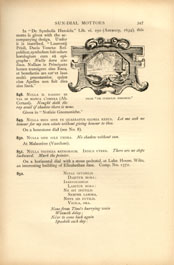
[Full Image]
FROM 'DE SYMBOLIS HEROICIS'.
In "De Symbolis Heroicis," Lib. vi. 250 (Antwerp, 1634), this motto is given with the accompanying design. Under it is inscribed, "Laurentij Prioli, Ducis Venetæ Reipublicæ, symbolum fuit solare horologium cum eâ epigraphe: Nulla hora sine linea. Nullam in Principatu horam transigere sine linea, et benefactio ars est et laus multò praestantior, quàm cùm Apelles non fuit dies sine lineâ." |
|
| 848. | NULLA IL RAGGIO MI VAL SE MANCA L'OMBRA (Ab. Certani). Naught doth the ray avail if shadow there is none. Given in "Notizie Gnomoniche." |
| 849. | NULLA MEIS SINE TE QUAERATUR GLORIA REBUS. Let me seek no honour for my own estate without giving honour to thee. On a honestone dial (see No. 8). |
| 850. | NULLA SINE SOLE UMBRA. No shadow without sun. At Malaucène (Vaucluse). |
| 851. | NULLA VESTIGIA RETRORSUM. INDICE UTERE. There are no steps backward. Mark the pointer. On a horizontal dial with a stone pedestal, at Lake House, Wilts, an interesting building of Elizabethan date. Comp. No. 1572. |
| 852. | NULLI OPTABILISNone from Time's hurrying wain |
While its few hours remain These lines and the free English rendering of them were written by the Rev. S. E. Bartleet, and put by him upon a dial which stood on the lawn of the vicarage garden at Crompton (or as it is more commonly called, Shaw), near Oldham, Lancashire. The dial-plate has since been moved into the churchyard and placed upon the shaft of the old mortuary cross, from which a previous plate had been stolen. The Latin lines were inserted in the "Guardian," and they have been inscribed, but in slightly different order, upon a dial erected by Henry Hucks Gibbs, Esq., at Aldenham Manor House, Elstree. It is worth recording that this motto of Mr. Bartleet's has received, from several people, the compliment of being considered "too good to be true." He had so thoroughly caught the style and spirit of the mediæval inscriptions that one correspondent went so far as to write to the "Guardian," and contradict the fact of Mr. Bartleet's authorship by stating that Lord Coleridge found the motto on an old clock in Devonshire, and gave it to Mr. Justice Denman to translate, who handed it in to the correspondent! It is due to Mr. Bartleet to give an extract from Lord Chief Justice Coleridge's reply to this statement, adding the explanatory fact that Mr. Bartleet's dial was made and engraved in Manchester, and exhibited in a shop-window there, before it was set up at Shaw. Lord Coleridge wrote: 28 Oct. 1889. – "It was given me many years ago as having been seen at Manchester, and as I understood, on a dial. I was charmed with the verses, and in speaking of them said, I thought they must be mediæval, but that I did not know the author in the least. I gave them to my friend, Mr. Justice Denman, who gave me in return a very fine version of it. . . . I am very glad to know the real author. Mr. Justice Denman tells me that he very likely mentioned Devonshire, having forgotten that I had spoken of Manchester, and from the fact that I live in Devonshire in the neighbourhood of fine old churches and houses." The following translation was given by Mr. Justice Denman to Mr. C. E. Kempe, who inscribed it on a window dial at Old Place, Lindfield, Sussex: TO NO ONE IS GIVEN |
A slightly different version, also attributed to Mr. Justice Denman, has appeared in the "Guardian"; and another translation by Sir Herbert Maxwell, Bart., was given in "Blackwood"s Magazine," Jan. 1891. See No. 526. |
|
| 853. | NULLIUS PŒNITEAT. May no hour cause thee to regret it. On the Church at Nemours (Seine et Marne). |
| 854. | NUMERA UTERE PROPERA. Count them, use them, make speed. On the Presbytère of St. Pierre des Corps, Tours. Also on a former Jesuit college at Tours, with No. 1194. |
| 855. | NUMERARE DIES NOSTROS ITA DOCE NOS UT INDUCAMUS ANIMUM SAPIENTIÆ. A.D. 1664. So teach us to number our days that we may apply our hearts unto wisdom. – Psalm xc. 12. This text, which is taken from the Zurich version of the Bible printed in 1543, is engraved on the north side of a cube of red sandstone which was found in 1873 at Woodford Halse, Northamptonshire. The cube is 8 ½ in. wide on each side, and 8 ¼ in. high. It was discovered in "Parson's Close," adjoining the Vicarage garden, in a pond which was being emptied. On the east, south, and west sides there are dial faces, but the gnomons are lost. The east and west dials are drawn on parallelograms set diagonally with the face, and show the hours from 4 to 10 a. m., and 2 to 8 p. m. respectively. In the base is a carefully made semi-globular cavity, 4 in. in diameter, and this was probably for the sake of accurate adjustment. On the top there is also a small cavity. The "Zurich" Bible is a Latin translation from the Syriac. |
| 856. | NUMERAS MOMENTA, DIES METIRIS ET ANNOS, Thou numberest the moments, thou measurest the days and years, knowing not what hour may bring the last day. On the Abbey of St. Corneille, near Campiègne, in 1816. |
| 857. | NUMQUAM AURI, SED OCULO SAEPE GRATA. 1742. Never acceptable to the ear, but often to the eye. This motto was read in 1870 on a south-west declining dial, on the wall of the courtyard of the Mairie at Perpignan. It stood between windows, some distance below the overhanging Spanish roof, whose border of greenish glazed tiles rests here and there on carved wooden owl-like figures, which project like gargoyles from the wall. There were two or three dials in this court over the low marble arcades, but only one bore an inscription. The building itself forms a part of the old |
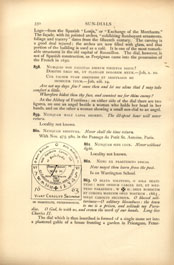
[Full Image]
IN PRIESTGATE, PETERBOROUGH.
Loge – from the Spanish "Lonja," or "Exchange of the Merchants." The façade, with its pointed arches, "exhibiting flamboyant ornaments, foliage and tracery" dates from the fifteenth century. The carving is a good deal injured; the arches are now filled with glass, and that portion of the building is used as a café. It is one of the most remarkable structures in the old capital of Roussillon. The dial however, is not of Spanish construction, as Perpignan came into the possession of the French in 1650. |
|
| 858. |
NUMQUID NON PAUCITAS DIERUM FINIETUR BREVI? Are not my days few? cease then and let me alone that I may take comfort a little. Wherefore hidest thou thy face, and countest me for thine enemy? At the Abbey of Ferrières; on either side of the dial there are two figures, on one an angel beside a woman who holds her head in her hands, and on the other a woman showing a small sun-dial to an angel. |
| 859. | NUNQUAM MALE LAPSA REDEBIT. The ill-spent hour will never return. Locality not known. |
| 860. | NUNQUAM REDITURA. Never shall the time return. With Nos. 475, 980, in the Passage du Petit St. Antoine, Paris. |
| 861. | NUNQUAM SINE LUCE. Never without light. Locality not known. |
| 862. | NUNC EX PRAETERITO DISCAS. Now mayst thou learn from the past. Is on Warrington School. |
| 863. | O BEATA SOLITUDO, O SOLA BEATITUDO : MIHI OPIDUM CARCER EST, ET SOLITUDO PARADISUS. W ✠ H. DEUS NOBISCUM ET CORONA MANUUM OPUS NOSTRUM . 1663 . VIVAT CAROLUS SECUNDUS. O blessed solitariness – O solitary blessedness : the town to me is a prison, and solitude my Paradise. O God, be with us, and crown the work of our hands. Long live Charles II. The dial which is thus inscribed is formed of a single stone set into a plastered gable of a house fronting a garden in Priestgate, Peter- |
| borough. At the time when it was sketched the house belonged to Mr. G. Wyman. It was formerly held by a family named Hake, which may account for the initials, W. H. The crown on the lower part of the dial is much worn away. It was once gilt. | |
| 864. | O COONIEE CRE CHA GIARE AS TA MY HRAA. Oh, remember how short my time is. – Psalm lxxxix. 46. This motto, from the Manx Psalter, is, with Nos. 249, 1385, 1530, on a sun-dial which stands at the gateway of St. Patrick's Church, in the village of Patrick, near Holm Peel, Isle of Man. The dial is of Pooilvaish marble from the quarries near Castletown. |
| 865. | O COUNT THE HOURS AS ONE BY ONE THEY FLY, On a cross dial erected for a member of the Baring family, possibly for a daughter of the first Lord Ashburton, who lived at Alverstoke, near Gosport. |
| 866. | O JÉSU MON AMOUR, DIEU SOIT BÉNI (sic). L'an VIIIde lare (? de la Republique) (1800). O Jesu, my Beloved, blessed be God. At the Hameau de Chimilin, near Aoste (Isère). |
| 867. | O JUNGFRAU DIE DER SCHLANGE FEIND, O Virgin, enemy of the serpent, remain ever the Elephant's friend, with thy protection cover this house, drive sickness, want, and every evil out. This motto, on the wall of the Gasthof zum Elephanten, Brixen, Tyrol, can only be explained by a description of the dial. It represents the Blessed Virgin crushing the serpent which has wound itself round the globe on which she stands. One foot is on the serpent's body, the other rests on the crescent moon, from beneath which the reptile strives to lift its head. The Virgin's eyes are raised to heaven, and she holds in her hand the lily and the cross. The hours are marked on a scroll across the globe, and the inscription is on another scroll below. The hotel takes its name from an Elephant which is painted in fresco on the other side of the house, where also is an inscription in old German explaining the picture, as follows: "Als mã sagt 1551 Jar dẽ 2 tag Juni furwar |
(As they say, 1551 year 2nd day of June in truth was this animal the Elephant, unknown in Germany, brought here by our high and mighty Prince our Lord Maximilian in Bohemia kingdom, Archduke of Austria. Andre Bosch who experienced this made Lenhart Mais paint it. God vouchsafe to hold the house in His protection, the inhabitants' body, honour, and property, to keep from harm. In 1645 Lenhart Muller had this renewed again.) There are also the following inscriptions: Wen da baut an der strassen muss Jederman zu davon reden lassen. 1713. In Jahre 1870 hat Hanns Heiss diese Bilder wieder erneuern lassen v. mal. AR. He who builds in the street must expect everyone to talk about it. 1713. In the year 1870 Hanns Heiss caused the pictures to be renovated by the painter (?) A. R. The sun-dial was probably painted at the same time. |
|
| 868. | O MORTEL, PENSE À LA MORT. O mortal, think upon death. At Les Brévières (Savoy). |
| 869. | O SOLEIL TU PARAIS, TU SOURIS, TU CONSOLES LA TERRE. 1852. O sun, thou appearest, thou smilest, thou comfortest the earth. On a house at La Vachette, on the road from Briançon to the Mont Genèvre. The dial is simply outlined, and has a peacock at the top. |
| 870. |
'Ω ΘΕΟΣ, 'Ο ΘΕΟΣ, ΜΟϒ ΠΡΟΣ ΣΕ 'ΟΡΘΡΙΖΩ. O God, thou art my God, early will I seek Thee. – Psalm lxiii. I, from the LXX. This verse is over the south porch of the church at Walkern, Herts."The inscription is nearly obliterated," said Archdeacon Grant of St. Alban's in 1878, "but ought certainly to be preserved." The following passage from Geikie's "Life of Christ" (vol. i., pp. 219, 222) helps to reveal the full meaning of this and similar verses in the Psalms."The morning sacrifice could not be slain before the first appearance of the morning light. A watcher, therefore, standing on the roof of the Temple, looked out for the first glimpse of Hebron, far off on the hills, as the sign of morning having come. When it was visible the summons was given: 'Priests, to your ministry! Levites, to your places! Israelites, take your stations!' The priests then once more washed their feet and hands, and the service finally began." With the first sight of the rising sun everyone bows his head in prayer, wherever at the moment he may be. Yonder a Pharisee, who has purposely let the hour overtake him in the street, suddenly stops, and ties his Tephillin broader and larger than common on his forehead and arm. |
| The olive gatherer, with his basket, prays when he is in the tree. Pilgrims and citizens are alike bent in prayer." | |
| 871. | O TV CHE IN ME GVARDI On the church of the Madonna di Campagna, near Pallanza. The dial lines are traced in red on a plastered wall; a skeleton, half length, is resting his right hand on the gnomon, and in his left holds a torch or scythe. The dial was sketched in 1888, and was then much defaced. |
| 872. |
O TU, QUI BINAM UNO GNOMONE CONSPICIS HORAM, The "hours twain" referred to in this motto indicated the arrangement of the figures on the dial, which, besides telling the hour of the day in the usual manner, also showed the time by the Italian mode of reckoning; that is, as the hours are counted from sunset to sunset, going through the whole course of the twenty-four numbers. The lines of these additional hours, from xii to xxiv, which were traced upon the dial plane, declared the time by the shadow of a point in the style, as it fell upon them. The dial itself was, when sketched in 1867, a large and wide one, the figures being represented in rolling clouds; and it was painted on a house wall that faces the sea at an opening of the main street of Cogoletto, a fishing village about eighteen miles west of Genoa, and a reputed birthplace of Christopher Columbus. The room in which, it is said, he was born, is still shown, and there are many inscriptions on the outside of the house testifying to the tradition, which were placed there by a member of the family in 1650. The tradition is firmly held by the inhabitants; and Washington Irving, who disputes the claims of all other places, save Genoa, nevertheless admits that there is some evidence in favour of Cogoletto. Admiral Colombo, with whom the great discoverer first sailed, was a native of this place; and the portrait of Columbus has been preserved here by his descendants. Tennyson seems to yield to this local claim: How young Columbus seem'd to rove, |
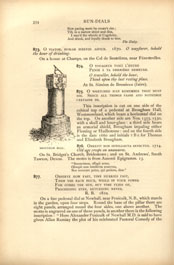
[Full Image]
BROUGHAM HALL.
Now pacing mute by ocean's rim; |
|
| 873. | O VIATOR, HORAM BIBENDI ASPICE. 1870. O wayfarer, behold the hour of drinking. On a house at Champs, on the Col de Sestrières, near Fénestrelles. |
| 874. | O VOYAGEUR VOICI L'HEURE At St. Siméon de Bressieux (Isère). |
| 875. | O WRETCHED MAN REMEMBER THOU MUST DIE. SENCE ALL THINGS PASSE AND NOTHINGE CERTAINE BE. This inscription is cut on one side of the cubical top of a pedestal at Brougham Hall, Westmoreland, which bears a horizontal dial on the top. On another side are Nos. 1355, 1530, with a skull and hour-glass: a third side bears an armorial shield, Brougham impaling either Fleming or Hudlestone: and on the fourth side is the date 1660 and initials T B E for Thomas and Elizabeth Brougham. |
| 876. | OBREPIT NON INTELLECTA SENECTUS. 1714. Old age creeps on unawares. On St. Bridget's Church, Bridestowe; and on St. Andrews', South Tawton, Devon. The motto is from Ausonii Epigramm. 13. "Senescimus, effugit aetas, |
| 877. |
OBSERVE HOW FAST, TIME HURRIES PAST, On a fine pedestal dial at Newhall, near Penicuik, N. B., which stands in the garden, upon four steps. Round the base of the pillar there are eight panels, arranged round the four sides, one above another. The motto is engraved on one of these panels, in another there is the following inscription : "Here Alexander Penicuik of Newhall M. D. is said to have given Allan Ramsay the plot of his celebrated Pastoral Comedy of the |
| Gentle Shepherd." This explains the contents of the six remaining panels. (1) Contains a design consisting of shepherd's crook, and other pastoral implements. (2) Habbie's How, and Mause's Cottage (Habbies's How is a romantic spot in the neighbourhood of Newhall, and Mause is one of the characters in the comedy). (3) The Washing Green, and Symon's House. (4) The Craigg Bield and Gland's Onstead (Gland and Symon are characters in the poem). (5) A ship inclosed in an oval margin. (6) "Here Allan Ramsay recited to his distinguished and literary patrons, as he proceeded with them, the scenes of his unequalled Pastoral Comedy, amid the objects and characters introduced into it." | |
| 878. | OCVLIS NON AVRIBVS ADSVM. I speak to eyes, not ears. In 1859 this motto was on the Abbey of Royamont (Seine et Marne). The chronogram gives the date of the construction of the dial 1672, a year in which many important repairs of the building were made. |
| 879. | ODIUM SINE SOLE TRANSIT. Hatred passeth by without the sun. With No. 343. On the Mairie at Voulx (Seine et Marne). |
| 880. | O'ER EVERY HOUR THAT'S BRIGHTEST Suggested as a motto by the Rev. S. E. Bartleet. |
| 881. |
OF SHADE AND SUNSHINE FOR EACH HOUR This stanza is at Dial House, Wadsley, near Sheffield, on a stone dial let into the wall. |
| 882. | OGGI IN VITA, DIMANE MORTO. In life to-day, to-morrow dead. At Bon Conseil, Savoy; and at Chapelle St. Jacques. |
| 883. |
On a house, Piazza San Michele, Ventimiglia. |
| 884. | OH! EMPLOYEZ-LES BIEN. 1835. Oh! use them well. At Mirabel, France. |
| 885. | OH QE LE TEMPS PASSE VITE! Oh, how quickly time passes! This quaintly spelt motto was seen in 1860 over the door of a small house which stood in a garden a little distance from the road between Cannes and Grasse. The dial was circular and faced south. It represented the sun, full-face, broad and smiling, with his hair dressed after the fashion of a king in a pack of cards, on a green background. He held the gnomon like a pipe in the corner of his mouth, and seemed to be regretting the swift passage of a jolly life. |
| 886. | OISIF, LE TEMPS PASSE. Idler, time passes away. At Elne (Pyrénées Orientales). |
| 887. | OMBRA FALLACE, CHE MENTRE S'APPRESSA FUGGE. Ah, cheating shade, thy near approach is flight. No place assigned. |
| 888. |
OMBRA FUGACE DALLA LUCE USCITA At San Bartolomeo, near Spezia. |
| 889. |
At Mayres (Isère). |
| 890. | OMNE TULIT PUNCTUM QUI MISCUIT UTILE DULCI (Hor. "Ars Poetica," 343). He who has mingled sweetness with utility has gained the applause of all. On a dial erected by the late Sir John Peter Grant, G.C.M.G., K.C.B., in the kitchen garden at Rothiemurchus, Aberdeenshire. The garden is very beautifully situated on the slope of Ord Bain Hill, and the pedestal stands at the intersection of four grassy paths bordered with flowers and vegetables growing together, an intermixture which led to the selection of the motto. |
| 891. | OMNES AEQUALES SOLA VIRTUTE DISCREPANTES. All men are equal, and differ only in virtue. At the Hameau de l'Agnelas, Voiron (Isère). |
| 892. | OMNES SECANT, ULTIMA NECAT. All wound, the last kills. At Vispthal. |
| 893. | OMNES SINT DEO. 1868. Let all men be for God. Route des Salces, Perpignan. |
| 894. | OMNES TIME PROPTER UNAM. Fear every hour because of one (the last). At Visp, Switzerland. |
| 895. | OMNES UNA NOS MANET. One hour awaits us all alike. At La Thuile de Granier, Savoy. |
| 896. | OMNES VULNERANT, ULTIMA NECAT. All wound, the last kills. This motto, with Nos. 108, 443, is on a dial at Cadder, near Glasgow. The dial consists of a stone block, 14 3/4 inches square, mounted on a shaft three feet high. "On the east, west, and south faces there are large cup hollows, 9 3/4 inches in diameter, all carefully lineated. Over each hollow is a motto. The gnomons consist of thin pieces of metal stretched across the cups. There is a metal dial plate on the upper surface, with a most beautifully worked gnomon of thin brass, perforated and chased, and containing the arms of the Maitland and Lauderdale family – a lion rampant within a double tressure." On the north side of the dial are the initials of Charles Maitland and his wife, Lilias Colquhoun, entwined, with the date 1698. Lilias Colquhoun was the widow of Sir John Stirling, of Keir, and had his estate of Cadder settled on her for life. She married, secondly, Charles Maitland, son of the third Earl of Lauderdale. |
| 897. | OMNIA A DEO. 1668. All things are from God. The family motto of Prince Rospigliosi, which, with his coat of arms is on a sun-dial on the farm at Spicchio, near Lamparecchio, belonging to the Villa Rospigliosi. |
| 898. | OMNIA CUM TEMPORE PRÆTEREVNT. All things pass away with time. On a small brass sun-dial and calendar in the British Museum. It is beautifully engraved with the face of the sun and other ornaments. |
| 899. | OMNIA FERT ÆTAS. Time brings all things. (From Virgil, Ecl. ix. 51.) On the porch of an Elizabethan manor house in the village of North Luffenham. |
| 900. | OMNIA FIT ÆTAS. Time does all things. On an octahedral dial in Mr. Evans' collection. See No. 295. |
| 901. | OMNIA HUMANA VANA. All human affairs are but vanity. Locality unknown. |
| 902. | OMNIA SOMNIA. A.D. 1680. All things are dreams. On the convent of St. Ursula, Valetta. |
| 903. | OMNIA SUNT HOMINUM PENDENTIA FILO. 1764. All things that are of men are hanging on a thread. On the Lodge, Wentworth Woodhouse, Yorkshire. |
| 904. | OMNIA TEMPUS HABENT. To everything there is a season. (Eccl. iii. I.) On the church of St. Stefano, Belluno (see No. 312). |
| 905. | OMNIA VANA. All is vanity. On the engraving of a dial in "der unbetrügliche Stunden Weiser," by J. H. Muller. 1702. |
| 906. | OMNIA VELUT UMBRA. All is as a shadow. At Aups (Var). |
| 907. | OMNIBUS BREVIS ULTIMA MULTIS. This hour is short for all, their last for many. At Castanel (Tarn). |
| 908. | OMNIBUS EXEMPLUM ET REGULA. A pattern and a rule to all. On the church of St. Joseph (which formerly belonged to the Jesuits), at Montauban (Tarn et Garonne). |
| 909. | OMNIBUS EXORITUR. For all men he rises. Place unknown. |
| 910. | OMNIBUS HORA VELUT ULTIMA JUDICETUR. Let the hour be judged for all men as though it were the last. Locality unknown. |
| 911. | OMNIBUS HORIS ORA. Pray at all hours. In front of the Presbytère at Larroque (Ariège). |
| 912. | OMNIBUS INCERTA. No man knoweth it. At Voreppe (Isère). |
| 913. | OMNIBUS LUCET. The (sun) shines for all. On the tower of Long Sutton Church, Lincolnshire. |
| 914. | OMNIS SPIRITUS LAUDET DOMINUM. Let everything that hath breath praise the Lord (Psalm cl. 6). Formerly at Great Smeaton, Yorkshire (see No. 647). |
| 915. | ON THIS MOMENT HANGS ETERNITY. Formerly on the church tower of Alfrick, Worcestershire (compare No. 172). |
| 916. | ONCE AT A POTENT LEADER'S VOICE I STAY'D, Taken from Cyrus Redding's "Fifty Years' Personal Recollections." |
| 917. | ONLY AS I ABIDE IN THE LIGHT OF HEAVEN On a glass window dial at Charlesfield, Midlothian, placed there by H. B. McCall, February, 1895. |
| 918. | OPPOSTO DI ME, Think of thyself instead of me. At the Château of the Count Pinsuti, in Piedmont. |
| 919. | OPTIMA FORTE TIBI. Perchance thy happiest hour. At Barraux (Isère). |
| 920. | ORA EST HORA. 1858. Pray, 'tis the time. On the curé's house at St. Quentin (Isère). |
| 921. | ORA ET LABORA. Pray and work. On a church at Northhallerton, Yorks.; and at West Wickham House, Surrey. Also with other mottoes on a cross dial at the House of Mercy, Horbury, near Wakefield (see Nos. 278, 1629). |
| 922. | ORA NE TE FALLAT HORA. 1760. Pray that the hour take thee not unawares. At Auberives (Isère); on the church at Cavaillon (Vaucluse); on a house at Plampinet (Hautes Alpes); and at Le Puy St. André, 1868. The last two dials were designed by Zarbula. |
| 923. |
1870. Respublica. Pray that the hour, gliding like water, swift as the wind, take thee not unawares. On the Presbytère, La Vachette (Hautes Alpes). The dial is surmounted by a bird, in Zarbula's style. |
| 924. | ORA NE TE RAPIAT HORA. Pray that thou fallest not a prey to the hour. On the tower of a large modern church in a village of the Val Sesia, near Varallo. Also on two of Zarbula's dials, one at Château Queyras, |
| dated 1848, the other on the church at Molines, Queyras, dated 1849. The same motto as ORA UT TE RAPIAT HORA is on the Hôtel de Ville, Anêt (Eure et Loire). ORA NE TE PROBET HORA, Pray that this hour may not be thy hour of trial, is on the church at Tèche; at Les Avenières; and La Rivière (Isère). | |
| 925. | ORA NE TE ULTIMA FALLAT. Pray lest the last hour take thee unawares. Formerly on the Convent des Minimes, Paris. |
| 926. | ORBEM IDONEO TOTVM IMPLEAT. May he fill the whole world with the light which brightens it. On a book-shaped portable brass dial in the Musée Cluny, Paris. |
| 927. | ORBIS ET UMBRA. A circle and a shadow. At Rome. |
| 928. | ORDINATIONE TUA PERSEVERAT DIES. The day continues according to Thine ordinance. At the Salle d'Asile, Mende (Lozère). |
| 929. | ORDINATIONE TUA, REGE ET PROTEGE. By thy ordainment rule and protect. On Visp Church, Switzerland. The motto is on the dial face, which also has a sun and a church painted on it. It is also on a house at Sion, Canton Valais. |
| 930. |
ORIENS EX ALTO VISITAVIT NOS: The first line is on the east face, the second on the west face of a dial at Round House Farm, Haverfield, Gloucestershire. VISITAVIT NOS ORIENS EX ALTO is written on an illustration of an east dial in a French MS. on dials in Mr. L. Evans' possession, apparently written at Nancy in the first half of the eighteenth century. |
| 931. | ORIENS NOMEN EJUS. Arising in his name. Formerly above the door of the Maison des Jésuites, Rue St. Jacques, Paris. |
| 932. |
ORIENS SOL ADORNATUR. On one of four dials which surround the pedestal of a globe dial in Mr. A. Egginton's kitchen garden, South Ella, near Hull. The |
